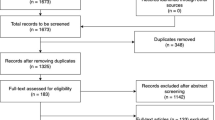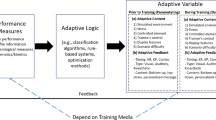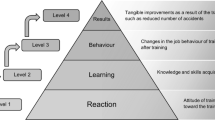Abstract
Prior to adopting new technologies for training, evaluations must be executed to demonstrate their benefit. Specifically, the appeal of virtual reality has led to applications across domains. While many evaluations have been conducted on their effectiveness, there has yet been a review to summarize and categorize the evidence on training outcomes. To assess the benefits these new technologies may bring to the trainee, a review of the research on the training effectiveness with virtual reality (VR) technology that was conducted. The goal for this review was to take a domain-agnostic perspective to identify the knowledge, skills, and abilities (KSAs) that have been trained effectively or enhanced with the use of VR. This review searched the related literature within multiple databases and found publications that met the search criteria from 1992 to 2019. A discussion of previous VR training reviews is first presented, followed by an in-depth evaluation of the literature that met the inclusion criteria. Three distinct categories of KSAs were identified consistently: psychomotor performance, knowledge acquisition, and spatial ability. Recommendations to support achievement of training outcomes utilizing VR training systems are provided.




Similar content being viewed by others
References
Aïm F, Lonjon G, Hannouche D, Nizard R (2016) Effectiveness of virtual reality training in orthopedic surgery. Arthroscopy: The Journal of Arthroscopic & Related Surgery, 32(1), 224-232
Alaker M, Wynn GR, Arulampalam T (2016) Virtual reality training in laparoscopic surgery: a systematic review & meta-analysis. Int J Surg 29:85–94
Aldrich C (2009) Virtual worlds, simulations, and games for education: a unifying view. Innovate: J Online Educ: 5(5), Article 1
Ausburn LJ, Ausburn FB (2004) Desktop virtual reality: a powerful new technology for teaching and research in industrial teacher education. J Ind Teacher Educ 41(4):1–16
Bailey SK, Johnson CI, Schroeder BL, Marraffino MD (2017) Using Virtual Reality for Training Maintenance Procedures. In: The proceedings of interservice/industry training, simulation, and education conference 2017 (No. 17108), Orlando, Fl
Bliss JP, Tidwell PD, Guest MA (1997) The effectiveness of virtual reality for administering spatial navigation training to firefighters. Presence: Teleoperators & Virtual Environments, 6(1), 73-86
Boud AC, Haniff DJ, Baber C, Steiner SJ (1999) Virtual reality and augmented reality as a training tool for assembly tasks. In: Proceedings of IEEE International Conference on Information Visualization 1999 (pp 32–36)
Buttussi F, Chittaro L (2017) Effects of different types of virtual reality display on presence and learning in a safety training scenario. IEEE Trans Visual Comput Graph 24(2):1063–1076
Carlson P, Peters A, Gilbert SB, Vance JM, Luse A (2014) Virtual training: learning transfer of assembly tasks. IEEE Trans Vis Comput Graph 21(6):770–782
Colquitt JA, LePine JA, Noe RA (2000) Toward an integrative theory of training motivation: a meta-analytic path analysis of 20 years of research. J Appl Psychol 85(5):678
Detmer FJ, Hettig J, Schindele D, Schostak M, Hansen C (2017) Virtual and augmented reality systems for renal interventions: a systematic review. IEEE Rev Biomed Eng 10:78–94
Erel E, Aiyenibe B, Butler PE (2003) Microsurgery simulators in virtual reality: review. Microsurgery 23(2):147–152
Farra SL, Miller ET, Hodgson E (2015) Virtual reality disaster training: translation to practice. Nurse Educ Pract 15(1):53–57
Fitts PM, Posner MI (1967) Human performance. Brooks/Cole, Michigan
Freina L, Ott M (2015) A literature review on immersive virtual reality in education: State of the art and perspectives. eLearn Softw Educ 1:133–141
Gillespie R, Nicholson J, Bickerdike S, Frith G, Hassan T (2019) Comparison of virtual reality versus standard video for point-of-training feedback after cardiopulmonary resuscitation simulation: A mixed methods study. Resuscitation. https://doi.org/10.1016/j.resuscitation.2019.06.139
Gurusamy K, Aggarwal R, Palanivelu L, Davidson BR (2008) Systematic review of randomized controlled trials on the effectiveness of virtual reality training for laparoscopic surgery. British J Surg 95(9):1088–1097
Hays RT, Vincenzi DA (2000) Fleet assessments of a virtual reality training system. Military Psychol 12(3):161–186
Hsu EB, Li Y, Bayram JD, Levinson D, Yang S, Monahan C (2013) State of virtual reality based disaster preparedness and response training. PLoS Currents. https://doi.org/10.1371/currents.dis.1ea2b2e71237d5337fa53982a38b2aff
Jang S, Vitale JM, Jyung RW, Black JB (2017) Direct manipulation is better than passive viewing for learning anatomy in a three-dimensional virtual reality environment. Comput Educ 106:150–165
Joda T, Gallucci GO, Wismeijer D, Zitzmann NU (2019) Augmented and virtual reality in dental medicine: a systematic review. Comput Biol Med 108:93–100
John NW, Pop SR, Day TW, Ritsos PD, Headleand CJ (2017) The implementation and validation of a virtual environment for training powered wheelchair manoeuvres. IEEE Trans Vis Comput Graph 24(5):1867–1878
Li C, Liang W, Quigley C, Zhao Y, Yu LF (2017) Earthquake safety training through virtual drills. IEEE Trans Vis Comput Graph 23(4):1275–1284
Loomis JM, Blascovich JJ, Beall AC (1999) Immersive virtual environment technology as a basic research tool in psychology. Behav Res Methods Instr Comput 31(4):557–564
Murcia-Lopez M, Steed A (2018) A comparison of virtual and physical training transfer of bimanual assembly tasks. IEEE Trans Visual Comput Graph 24(4):1574–1583
Nagendran M, Gurusamy KS, Aggarwal R, Loizidou M, Davidson BR. Virtual reality training for surgical trainees in laparoscopic surgery. Cochrane Database of Systematic Reviews 2013, 8(CD006575). https://doi.org/10.1002/14651858.cd006575.pub3
Norris MW, Spicer K, Byrd T (2019) Virtual reality: the new pathway for effective safety training. Profess Saf 64(6):36–39
Parong J, Mayer RE (2018) Learning science in immersive virtual reality. J Educ Psychol 110(6):785
Pelargos PE, Nagasawa DT, Lagman C, Tenn S, Demos JV, Lee SJ, Bari A (2017) Utilizing virtual and augmented reality for educational and clinical enhancements in neurosurgery. J Clin Neurosci 35:1–4
Piromchai P, Avery A, Laopaiboon M, Kennedy G, O’Leary S (2015) Virtual reality training for improving the skills needed for performing surgery of the ear, nose, or throat. Cochrane Database Syst Rev. https://doi.org/10.1002/14651858.CD010198.pub2
Pulijala Y, Ma M, Pears M, Peebles D, Ayoub A (2018) Effectiveness of immersive virtual reality in surgical training: a randomized control trial. J Oral Maxillofac Surg 76(5):1065–1072
Sheridan TB (1992) Musings on telepresence and virtual presence. Pres Tel Virtual Environ 1(1):120–126
Smith JW Salmon JL (2017) Development and Analysis of virtual reality technician-training platform and methods. In: Proceedings of Interservice/Industry Training, Simulation, and Education Conference 2017
Stone R (2001) Virtual reality for interactive training: an industrial practitioner’s viewpoint. Int J Human-Comput Stud 55(4):699–711
Stone RT, Watts KP, Zhong P (2011) Virtual reality integrated welder training. Weld J 90(7):136s
Stroud KJ, Harm DL, Klaus DM (2005) Preflight virtual reality training as a countermeasure for space motion sickness and disorientation. Aviat Space Environ Med 76(4):352–356
Tate DL, Sibert L, King T (1997) Virtual environments for shipboard firefighting training. In IEEE Virtual Reality Annual International Symposium, 1997 (pp 61–68)
Tichon J, Burgess-Limerick R (2011) A review of virtual reality as a medium for safety related training in mining. J Health Safety Res Pract 3(1):33–40
Vaughan N, Dubey VN, Wainwright TW, Middleton RG (2016) A review of virtual reality based training simulators for orthopaedic surgery. Med Eng Phys 38(2):59–71
Wang P, Wu P, Wang J, Chi HL, Wang X (2018) A critical review of the use of virtual reality in construction engineering education and training. Int J Environ Res Public Health 15(6):1204
Webster RD (2014) Corrosion prevention and control training in an immersive virtual learning environment (Technical Report No. NACE-2014-3726). San Antonio, TX: NACE International
Yiannakopoulou E, Nikiteas N, Perrea D, Tsigris C (2015) Virtual reality simulators and training in laparoscopic surgery. Int J Surg 13:60–64
Funding
This research was accomplished under Contract No. N68335-19-C-0089. The views and conclusions contained in this document are those of the authors and should not be interpreted as representing the official policies, either expressed or implied, of NAWCTSD or the US Government. The US Government is authorized to reproduce and distribute reprints for Government purposes notwithstanding any copyright notation hereon.
Author information
Authors and Affiliations
Corresponding author
Additional information
Publisher's Note
Springer Nature remains neutral with regard to jurisdictional claims in published maps and institutional affiliations.
Rights and permissions
About this article
Cite this article
Abich, J., Parker, J., Murphy, J.S. et al. A review of the evidence for training effectiveness with virtual reality technology. Virtual Reality 25, 919–933 (2021). https://doi.org/10.1007/s10055-020-00498-8
Received:
Accepted:
Published:
Issue Date:
DOI: https://doi.org/10.1007/s10055-020-00498-8




